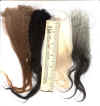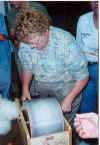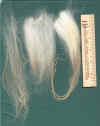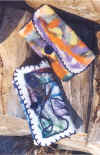|
|
Tongue River Farm
|
|
|
Tongue River Farm
|
All about Icelandic Fleece
Properties, Spinning tips and
washing instructions
©
Copyright Susan Mongold
Icelandic
Wool Has Unique Properties
The
Icelandic fleece is perhaps the world's most versatile fiber. Handspinners
wishing to spin a wide range of yarns for an even wider range of uses from a
single fleece, will be delighted to discover this fiber. Its versatility
suggests many projects and uses. The Icelandic fleece is dual coated, meaning
that it has a long outer coat called tog and a fine inner coat called thel.
Click on thumbnail pictures to
enlarge
 Four of the many colors of Icelandic fleece.
Four of the many colors of Icelandic fleece.
Historically
Icelandic fiber was separated for most uses. The tog was made into twine, rope
and embroidery thread. It was woven into canvas sails, saddle blankets, and
tapestries. Fine tog was used like mohair and knitted into lacy shawls, used for
embroidery work and made into durable items like aprons. Today it is regarded as
a perfect fiber for woven rugs. Thel was used for fine, soft, next-to-the-skin
garments, including baby clothes, fine worked mittens, and underwear. The two
coats when spun together were used for fisherman's sweaters, socks, and caps.
 Rug made with tog-rich britch (wool from the lower hind legs).
Rug made with tog-rich britch (wool from the lower hind legs).
Hand spun and woven by Suzanne Grosjean professional rug weaver 207-565-2282
Preparation of Wool for Spinning
Preparation
of a fleece for spinning can be done in several ways. The easiest way if you
have limited tools is to flick card the tips (uncut ends). Do not flick the cut
or butt end of the lock or much of the thel will be lost. Simply tease open the
cut end with your fingers and spin from this end. Spinning from the lock feeds
the two types of fibers evenly, and at the same time, reserves the interesting
color variations in the lock. This method produces semi-worsted yarn.
 Hand spun from the lock, hand knit sweater by Dawn Ann Tramp
Hand spun from the lock, hand knit sweater by Dawn Ann Tramp
Viking combs (those with one row of teeth) were designed to be used with this
fiber; such single pitch combs must be
The fiber can also be prepared on a drum carder. Use a fine
carding cloth with long teeth for best results. The locks must be well teased
open before carding to prevent the long fibers from wrapping around the
licker-in. Locks are usually too long to be carded with hand cards.
 Beth Abbott carding Icelandic wool on a Louet fine carder.
Beth Abbott carding Icelandic wool on a Louet fine carder.
Beth teaches workshops on spinning and felting Icelandic fleece. Contact her at--
Beth
Abbott
RR#2,Godfrey,Ontario,
Canada, K0H 1T0
SEE
WASHING INSTRUCTIONS BELOW
Two
Spinning Methods
The
two coats need not be separated, and are usually spun together by today's
spinners. However, if separation is needed, the tog and thel can be drawn apart
in the following ways.
The
simplest is to take a washed lock and pull on the tips of the tog end while
gently holding the cut (butt) end in the other hand. The tog pulls out fairly
easily.
 Separated fleece lock: Tog/ thel/ whole lock
Separated fleece lock: Tog/ thel/ whole lock
Another
method is to lay the lock on the teeth of a hand card placed face (teeth) up.
The long fibers can be pulled out while the short thel remains held fast
by the teeth of the card. If the tog that has been pulled out has been kept
aligned it can then be easily spun worsted. The thel may need more work to
relieve it of its shorter tog fiber. If put on a surface of contrasting
color the tog fibers can be seen and removed from the thel.
Icelandic
fiber, with its low amount of crimp, is easy and fun to spin. Even beginning
spinners can achieve a uniform yarn. The lack of crimp produces a relatively
inelastic yarn that is best used for garments that are designed to drape. These
yarns will make a fabric that will not stretch out of shape.
For
felting, Icelandic fiber has no equal. It felts fast in twenty minutes or less.
The delight in felting is that a project can be completed in twenty minutes to
an hour. This fiber also makes excellent knitted-then-felted items such as hats
and slippers.
Rex's hats (click photo to enlarge)
Icelandic
fleece is truly a spinner/weaver/felter/fiber artist's dream. With its
versatility and natural color, it's hard to beat for a great fiber experience.
 Felted purses by Sally Snyder.
Felted purses by Sally Snyder.
How to Wash Your Fleece by
Frances Smith
Why is it that many people,
perfectly capable otherwise, find themselves resisting the act of washing
fleece? Perhaps they see lovely fleeces at a fiber show where they
feel the lovely soft quality of the wool, and they can envision the fiber made
up into that special project they’ve been dreaming of. They’d love to use the pattern they bought so long ago to
create, from “scratch”, that perfect sweater, or vest (or fill in the
blank). Yet they are intimidated by
the idea of actually washing the fleece. Where
do they start? What if they do
something wrong and ruin the fiber?
Can we ruin the fiber?
Sure, but we can also ruin good sweaters, and that doesn’t stop us from
washing them. We just pay attention
to how we can do it safely. So
let’s look at how we can do the same thing with a fleece, and open the door to
all kinds of opportunities for ourselves.
First off, washing fleece
can be safe and relatively easy. It
can actually be the kind of experience we can enjoy!
Keeping in mind that Icelandic fleece has less lanolin in it than many
other kinds of fleece, this makes it easier for us to scour.
There are three things that we should keep in mind if we want to be
successful, and a few others that can make the job.
The three most important things to remember are:
Keeping in mind those three,
let’s take this process step by step.
The general rule of thumb
here is that any good detergent will work well.
For many years, soap was the agent of choice, simply because detergents
hadn’t been developed yet. But
soap is highly alkaline, and the alkali in soap opens up the scales on wool
fibers, aiding in the felting process. Since
we definitely don’t want our washed fiber to felt if we are going to spin it
(ever try spinning felt?), we want to stay far, far away from soap.
Detergent, on the other hand, is not as alkaline and contains a cleaning
agent known as a surfactant, which means that it makes water “wetter”,
breaks down the grease particles of lanolin and thereby aids in getting rid of
dirt. It is important, though, if
you are going to use detergent, NOT to get a detergent containing bleach, as the
bleach can make wool fibers brittle and rough.
An excellent washing agent
is a product made by Shaklee, called Basic H.
It is all natural product, is biodegradable, contains no harmful
chemicals, and does a beautiful job. It
is not a cheap solution—however, for most fleece and certainly Icelandic, one
wash will be enough, whereas with other detergents, often two or three washes
are necessary to do a good washing and scouring job.
About ¼ cup of Basic H to a washer load of fleece is sufficient, which
means that in the long run, you will be using much less and therefore not paying
more to get the same jobs done. The
Shaklee products are advertised as being good for the earth—actually some
farmers use the product as a natural wormer (clean the inside of the sheep and
also the outside?) For those of us
who are ecologically sensitive, this is an excellent solution.
Another popular choice is
Dawn dishwashing detergent, which has a good pH level, and seems to do a
excellent job. Most of the references I have found refer to using the
original blue product. I’ve read
that this product has even been used on birds caught in oil slicks, which says
something about not only its effectiveness, but its gentleness. To get the heavy awful oil out it has to have strength, but
if it’s used on the delicate feathers of birds without rendering them useless,
it also has to be mild and nontoxic.
There are a number of places
where our washing can take place: a
bathtub, a large washtub, or a washing machine are several.
If we choose the washing machine, we must remember our third most
important item above—NO AGITATION, EVER.
Wool, especially Icelandic wool, has a tendency to felt. In Icelandic wool, it approaches a compulsion!
Agitation, or rubbing the wool fibers against each other, causes felting.
Each individual fiber in a fleece has very small, microscopic scales that
normally lie flat against the fiber, allowing it to be an individual.
When the combination of heat, washing agent
and agitation are combined, those same scales “bloom”, opening up so
that they catch hold of other fibers and hold them irrevocably together as a
bound group, the “community” of felt.
Now that we have the washing
agent, let’s move on to the next step. We
can either just wash our fiber to remove dirt, or we can do what is called
scouring, which is removing dirt AND lanolin.
Why should we want to remove the lanolin, which we’ve all heard is a
wonderful, moisturizing element popular in the lotions we put on our hands,
faces and bodies? It would seem
that this would be a positive thing, not a negative.
After all, doesn’t that contribute to the wonderful waterproofing of a
sheep? Well, all the above points
are true. However, lanolin as it
ages also undergoes a change and becomes sticky and hard, a substance that would
definitely have a negative impact on most of our projects.
Given that, we will probably want to scour the wool, which means using
very, very HOT water, up to 160 degrees if we can get it there.
We need the heat of the water to help soften the lanolin, so that it can
be dissolved and rinsed out of the fleece.
In a washing machine, we’ll want to use the hottest setting we can to
fill the washtub. If we are using
one of the other options, we may need to boil some water to add to the water
coming from the faucet, since we don’t have the insulating factor of the
washing machine body. For
simplicity, this article will focus on the use of a washing machine.
So let’s fill the empty
washtub now. DO NOT, I
repeat, DO NOT PUT THE FLEECE INTO THE TUB WHILE FILLING IT!
The very act of the water pouring over the fleece can felt it!
We start with the washtub empty and fill it with the HOT water discussed
above. After the tub is filled,
stop the wash cycle, and pour your washing agent in the water, stirring gently.
For Basic H, use ¼ cup. For Dawn,
use ½ cup. Use a paddle or durable
instrument to stir gently to distribute the washing agent evenly in the
water—the water will be too hot for your bare hands, or it won’t be hot
enough. At this time, move your
dial to the final spin part of your wash cycle.
Do this before you put the fiber in.
It’s too easy for someone, even you, to accidentally start up the wash
cycle without remembering to change the dial, and then your fiber will start to
felt, eliminating this fiber from being spun.
Now that the machine is stopped and your washing agent is in the water,
carefully lay small amounts of your fiber into the water, pushing it gently
down, being careful not to move it back and forth at all.
Do not put too much fiber in, or the water and washing agent can’t
circulate around it enough to clean it. Some
people really want to spin from the lock structure, and if you’re one of
those, you may want to put your fiber in mesh bags so that you’re sure not to
disturb that lock structure.
Let the fiber sit in the water for about 15-20 minutes, and then use your spin cycle to extract the water from the fleece. Do not let the fleece stand in the water for much longer than this, because that very lanolin and dirt which the hot water and detergent has been working on suspending in the water will settle back on the fiber, causing more washes to be necessary.
Also, be sure to use the
final spin cycle, so that the machine doesn’t go right into the rinse cycle,
energetically pouring water over your fiber and felting it into a lovely felt
bagel! Also, be VERY careful that there is no water coming into the
washer during the spin cycle—remember the lovely felted bagel?
If necessary, turn off the water coming into the washer while spinning,
but don’t forget to turn it back on when you’re finished!
After spinning, gently
remove the fleece and place it in a wash basket or other container, while you
refill the washer for the rinse/soak phase.
Use the same temperature of hot water for the rinse cycle so that you
don’t shock the wool and felt it, and follow the directions above without the
washing agent. If you want, you can
add a little vinegar to the rinse water; some people swear by this as a
finishing step to restore the natural pH of the fiber and release all the
detergent, thereby giving a softer feel to the fleece.
Now check the state of the water: is it cloudy?
If so, that indicates either residual detergent or dirt, and the fleece
needs to be rinsed. For Icelandic
fleece, one soaking/washing should be sufficient, with one rinsing.
Check this out by taking a handful of your fibers in your hand, squeezing
them gently. Now pat your hand dry
with a hand towel. When you open and close your hand into a fist, does it feel
tacky? If so, repeat the
washing/rinsing process. If not,
we’re a go for drying
Your fiber can be dried many ways; the important thing is to not spread it too thickly, to check it occasionally, and turn it if needed. Some folks have made screens that are three feet square and fit in a drying rack, so that the fiber lies on shelves about 6 inches apart. This is a good use of space. Others put the fiber on sweater dryers. Some individuals prefer to dry their fiber outdoors on nice days—if you do this, you may want to cover the fiber with a thin netting to keep it from blowing away should a wind come up. Whatever method you choose, be sure the fiber is dry before storing it in anticipation of the exciting job of spinning!
See fleeces for sale. Click here
|
Home | Breeding Stock | Products | Contact Us |
|
|
All
photos, graphics, and text: © Copyright Tongue River Farm, 2002 |